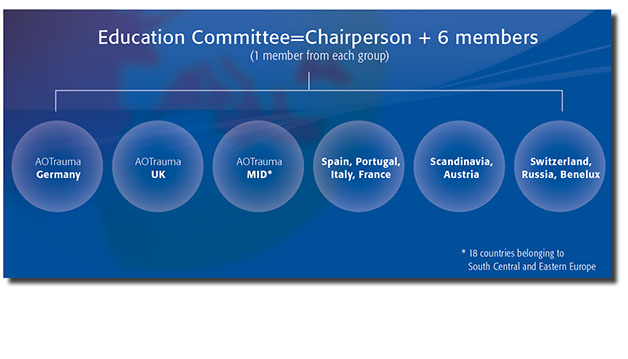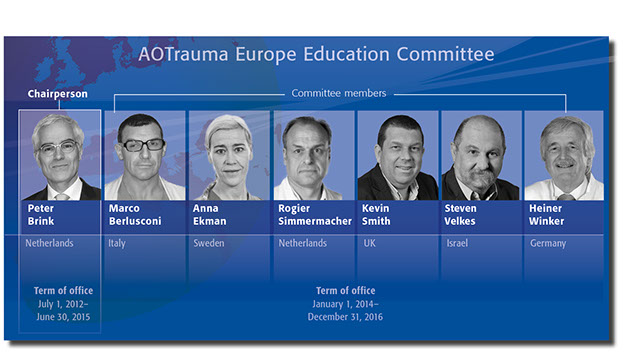
Spotlight on the new Europe Regional Education Committee
The AOTrauma Regional Education Committees (RECs) are tasked with overseeing the quality, coordination, and scheduling of all educational activities within their region. In the following issues of this newsletter, we will introduce you to one of the five regions. We begin here with our “youngest,” the Europe Education Committee, which will celebrate its first birthday in October 2014.

The AOTrauma Regional Education Committees (RECs) have been established to provide a key quality checkpoint for all educational activities that occur within each region. They have been mandated to coordinate, schedule, and provide fair distribution of these activities within their region.
This requires each Regional Committee to maintain a current understanding and overview of the educational needs and offerings within their respective regions.
The AOTrauma Regional Education Committees (RECs) have been established to provide a key quality checkpoint for all educational activities that occur within each region. They have been mandated to coordinate, schedule, and provide fair distribution of these activities within their region.
This requires each Regional Committee to maintain a current understanding and overview of the educational needs and offerings within their respective regions.
_________________________
Read an interview with AOTrauma Europe Education Committee Chairperson
Peter Brink.


This chart outlines how the 26 countries within the AOTrauma Europe region have been organized into “bubbles” or groupings. Note that geographical location does not dictate their placement.

While the role of RECs in our organization is relatively new, the necessary skills to make these groups effective are not new to us: team work, efficiency, cultural sensitivity, understanding of the dynamics between member countries, ability to see the big picture, and above all, a commitment to improving patient care.
Establishing a REC in Europe has taken the longest and in part due to the differences in culture and language that the “Europe” designation encompasses. Twenty-six countries are included under the Europe umbrella; while this diversity makes us stronger, it can also prolong the process of reaching consensus. However, what has emerged from the democratic committee design and election process is what we can all be proud of.
Since a committee of 26 members would encounter many difficulties in being effective, it was decided by the electorate that grouping countries together would be the fairest way of choosing representatives for the six committee positions. The Europe REC has an elected Chairperson who serves a three-year term. Currently, the Chairperson is Peter Brink from the Netherlands. Three of the Committee members are elected from a grouping or “bubble” of countries. The other three committee positions are filled by representatives from the UK, Germany, and the AOMID countries.

Interview with AOTrauma Europe Education Committee Chairperson Peter Brink
The Europe Education Committee is chaired by Peter Brink, who will serve in this elected role until 2015. Comprised of six additional members, the Europe REC has recently adopted its current configuration. All members are looking forward to the tasks and challenges they will undertake during their term.
What are some of the top priorities the Europe Education Committee will tackle over the next 3 years?
We recently made decisions about which members are responsible for particular topics. For example, we needed someone to take on the role of Regional Faculty Coordinator, who will coordinate the new Fellowship program within our region. We also need to look at faculty development in Europe and establish a transparent way to choose the best faculty for both regional and international courses. We must look at initiating coaching and training for Basic and Advanced Principles courses. We need to hold discussions about the annual Masters course and how to best select Chairpersons, venues, and topics. Finally, we want to have a stable and logical distribution of Basic Principles courses throughout Europe. For countries that do not hold their own courses, we will invite them to work with other countries in our region. Our list is ambitious.
What are the challenges the Europe Education Committee foresees?
We have many cultures and languages to navigate when making decisions about courses. North America, for example, runs about a fifth of the courses we offer in our region in a year. We need faculty, wet labs, and skills station tools to accommodate this. We often have a number of courses running in the same week throughout the region. Good attendance becomes crucial when offering so many courses, and surgeons from a number of countries can or will only attend with industry sponsorship. We have to find the correct balance between quality and price, keeping this in perspective with regards to what is reasonable in certain parts of Europe. We should not tighten the course format too much, thus leaving no room for national inputs.
Please share your vision for the AOTrauma Europe region.
I want us to maintain our strong brand and assert that quality control is essential. I see us staying at the top of the medical education field and further embracing blended learning. Increased collaboration with more industrial partners will make us more independent—an attribute that we celebrate and are known for. In terms of the AOTrauma network, I see it growing and attracting younger surgeons. We recognize that we do not only teach content but also nurture relationships and learn from one another. I hope our organization will influence healthcare systems around the world, for instance, with respect to direct availability of implants for acute fracture care. Adopting a more general role in healthcare would mean that our treatment methods and recommendations for patient care are implemented. The public should know that if they are treated by an AO surgeon they are receiving a high standard of care—any information patients might receive from AOTrauma would also bring this assurance.
______________________
About Peter Brink MD
Elected in 2012, Peter Brink is the current Chairperson of the Europe Education Committee. He is a practicing general and orthopedic trauma surgeon, heading the department of traumatology of the University Hospital in Maastricht (the Netherlands).

Interview with AOTrauma Executive Director Claude Martin jr.
As the Executive Director of AOTrauma, Claude Martin jr. works with the various elected boards, commissions, and committees of AOTrauma to design, develop, and implement strategic plans for the organization and its members. He oversaw the creation of the AOTrauma Europe Education Committee and spoke about the time needed for its establishment.
Can you give us a little background on the AOTrauma Europe Education Committee?
When I took this job in 2010, there was a Europe “education committee” that existed but it had limited decisional capacity. When AOTrauma became its own clinical division, educational event scheduling was handed over to the regions; Europe turned out to be an enigma. There are 26 countries offering AOTrauma education within the “Europe” region. For the few countries with an established tradition of educational activities, it was difficult to give up the task of regulating and distributing these activities to a regional body. The previous Europe Education Committee could not tackle the country level issues; it focused on the regional Masters courses and did a good job developing them into well-attended and very successful courses. The creation of a Europe Education Committee required building agreement on the democratic election rules for members. This conversation started in 2011, resulted in the election of a Chair (Peter Brink) and culminated at the 2013 General Assembly meeting where democratic election consensus and terms of reference were obtained for the six committee member positions.
Why did it take so long to establish a European Education Committee?
Some might highlight cultural differences as the reason behind this, but I think that history is the culprit. The same broad issues are being faced by the European Union as we speak—countries are worried that their collaboration within a group structure will impact them negatively. The EU continues to try to find mutually agreeable ground. We are also looking for the balance between national decision making at the country level but with clearly delineated allowances for more input and decision making at the regional level from the Education Committee. The other regions did not encounter the same roadblocks because they have fewer member countries and had fewer educational offerings at their inception.
Where would you like to see the Europe Education Committee in the future?
My vision is that every educational course scheduled in Europe goes through the regional committee for final approval. This would be based on a needs assessment done for the region and coordinated with national input.
_____________
About Claude Martin jr. MD
Based in Davos and Dübendorf, Switzerland, Claude is the Executive Director of AOTrauma. He is a Canadian-trained orthopedic hand surgeon who now is a member of AO Foundation's Executive Management.
AOTrauma
www.aotrauma.com | education@aotrauma.org
Copyright © 2014 AO Foundation. All rights reserved.
